Animal Facts
Scientific facts, information and pictures for dolphins, Whales, marine mammals and other animals.
Fascinating animal facts are paired with spectacular photographs of marine mammals, land animals and birds on this web site.
Detailed, scientifically accurate animal fact sheets will help readers gain an in-depth knowledge of animal species. The facts sheets are illustrated with exciting, close-up pictures of the animals in their natural habitat.
Information is organized by headings such as general description, identification features, habitat and range, feeding and diet, social structure, courtship and breeding, behavior, communication and life span. Common names, as well as the animal’s scientific name and classification are listed.
Marine mammals are animals that depend on the ocean environment for survival. Whales are some of the largest and most spectacular marine mammals, and one can often get close to them, and other wildlife, by taking a whale-watching tour. Before heading out, read the fact sheets about cetaceans (whales) such as orca whales, grey whales, humpback whales, sperm whales, belugas, dolphins, and other marine mammals such as seals, sea lions and others.
Interesting facts about animals that live on land or in the air are also featured, alongside hundreds of pictures covering a wealth of animal species. Discover large predators such as polar bears.
Bird lovers will enjoy reading the facts about birds, and can get to know even more about their favorite species. Check the bird fact sheets to learn about the plumages, call-notes, identification features, unique characteristics, and where to find birds such as the majestic bald eagle, great-blue heron, or sea birds such as gannets and puffins.
The animal facts sheets offer interesting, in-depth information about marine mammals, land animals, birds and other wildlife, accompanied by stunning pictures.
Here is another website which offers great pictures of animals. For our german speaking folks we recommend this website for animap pictures (Tierbilder): Tierbilder - Bilder von Tieren.
------------------------------------
Killer Whale Facts
Orcinus orca, Orca Whales
Killer Whale Facts: GENERAL DESCRIPTION:
The orca or killer whale is a toothed whale and is a member of the Dolphin family (it is the largest dolphin). There are 3 distinct species of these warm blooded, air breathing mammals: Resident Killer Whales, Transient Killer whales, and Off-shore Killer Whales. The main factors which set each species apart are - social behavior, physical appearance, preferred food, and vocal dialects. At this stage, there is little known of the Off-Shore species of Killer Whales as they are seldom seen in protected coastal waters. Although the travelling ranges of Residents Killer Whales, Transients Killer Whales, and Off-shores Killer Whales overlap, they have never been seen to mix.
Large Killer Whale male with British Columbia Coast Mountains in the background
One of the best locations for orca whale watching is off Vancouver Island in British Columbia, Canada. Here you can find a story about a orca whale watching tour off northern Vancouver Island, British Columbia. Check out this website for interesting pictures from British Columbia.
Killer Whale Facts: PHYSICAL CHARACTERISTICS:
Killer Whales are easily recognized due to their striking black and white coloration, and a sleek, streamlined, fusiform (tapered at both ends) body shape.
The rounded and paddle-like forelimbs are pectoral flippers which are used mainly to steer and, with the help of the flukes, to stop.
The dorsal fin acts as a keel and probably helps stabilize a killer whale. The dorsal fins of male killer whales are the tallest of any cetacean in the world, growing up to 1.8 m (6 ft.). Female dorsal fins are smaller at about 0.9 to 1.2 m (3-4 ft.) and may be slightly curved back.
Male killer whales, or bulls, begin maturing at 12 to 14 years of age and over the next few years, grow very quickly and attain physical maturity at about 20 years. Most males probably reach a length of 8 to 9 metres.
Females, or cows, average about 7 metres in length and reach reproductive maturity at about 14 to 15 years. The gestation period is 16 to 17 months. A single calf is usually born (although twins have been recorded). 200 kilograms. Newborn killer whales nurse for at least one year. The mortality rate of calves is quite high - over 40% of resident calves die in their first six months.
Killer Whale Facts: DIET AND TEETH:
Resident Killer Whales eat predominantly fish (Salmon, Lingcod, halibut, greenling, and various small flatfish). Although they are often seen in the vicinity of other marine mammals they usually ignore them. There are only a few examples of resident pods attacking seals or porpoises. Transients Killer Whales, in contrast to Residents, feed almost exclusively on marine mammals or seabirds. The favoured prey of transients is harbour seals, sea lions, and porpoises. Very little is known about the diet of the Off Shore species, but it is believed that they prey on fish for at least part of the year, however preying on Marine Mammals is also possible.
Killer whales often hunt cooperatively in pods for food. They work together to encircle and herd prey into a small area before attacking. When hunting a large whale, a pod of killer whales may attack from several angles (generally transients).
The conical and interlocking teeth of killer whales are well suited for a wide variety of prey, from small schooling fish to large whales. The number of teeth varies among individuals - but there are usually 10 to 14 teeth on each side of the jaw, a total of 40 to 56 teeth. Each tooth is about 7.6 cm (3 in.) long and approximately 2.5 cm (1 in.) in diameter.
Adult killer whales eat approximately 3% to 4% of their body weight in food per day, fully weaned calves can eat up to approximately 10% of their body weight during growth periods.
Killer Whale Facts: BEHAVIOUR:
Most studies have been carried out on Resident Killer whales who live in small, close-knit, groups called pods. The size of a resident pod varies from as few as 3 to as many as 50 individuals who tend to travel within specific ranges.
Resident Killer Whales live and travel in groups or pods organized along lines of maternal relatedness. Studies of resident killer whales have been able to identify maternal lineage through the tight bond between mother and offspring. Paternal lineage is unknown.
Transients on the other hand often travel alone, or in groups of two to seven individuals, and their travelling ranges are unpredictable.
Breaching Killer Whale female
The social system of transients is more fluid than the stable associations of residents. A typical transient group might comprise of a mother and two or three off-spring, or perhaps of several adult females of unknown relationship. Some offspring leave their mother's group as adolescents, often following the birth of a younger sibling. Adult male transients are seldom found travelling solely with other adult males.
Killer Whale Facts: ACTIVITIES:
Killer whales exhibit a wide variety of activities as they go about their daily lives. The activities of killer whale groups fall into four categories: foraging, travelling, resting, and socializing.
Foraging is the most common activity, and appears where the whales are feeding or appear to be searching for food. Different patterns of foraging are evident in both residents and transients, depending on the type of prey. Members of a pod frequently cooperate in hunts.
Travelling is when a group of killer whales are travelling consistently in one direction in a moderate to fast pace in relatively tight formation. They may travel from one good feeding spot to another, or it could simply be a means of transiting an area.
Members of a group will often rest after foraging. The whales typically group together, diving and surfacing as a cohesive unit. When resting, whales slow down and at times stop altogether, and usually become very quiet underwater. Periods of rest may last from less than an hour to more than 7 hours. Resting is not very common in transients.
Socializing among killer whales includes a great variety of interactions between members of the group. Behaviours seen during socializing episodes include various aerial displays including breaching, spy-hopping, tail slapping, beach rubbing, and flipper slapping. Whales may also interact with inanimate objects such as kelp and have also been seen to surf in the wake of passing boats.
Killer Whale Facts: SENSES & COMMUNICATION:
Killer whales can also be distinguished by the kinds of underwater communication sounds they produce - squeals, squawks, and screams are used for social communication within and between groups. Killer Whale clans, like dolphins, can be distinguished by their different dialects.
Killer whales have acute hearing and also acute vision both in and out of the water.
Echolocation enables them to locate and discriminate objects by projecting high-frequency sound waves and listening for echoes. Killer whales echo-locate by producing clicking sounds and then receiving and interpreting the resulting echo.
-------------------------------------------
Killer Whale Facts: LIFE SPAN:
Some males have been known to live well into their 40s and perhaps to 50-60 years old. Females have been known to live to 60-80 years old.
____________________________________
Facts: The orca or killer whale is a toothed whale and is a member of the Dolphin family (it is the largest dolphin)... Killer Whale Facts
Humpback Whale Facts
Megaptera novaeangliae
Facts: Humpback Whales are mammals belonging to the baleen whale suborder and can be found in oceans and seas... Humpback Whale Facts
Sperm Whale Facts
Physeter macrocephalus
Facts: The Sperm Whale is the largest of the toothed whales and is the largest toothed animal in the world. The whale was... Sperm Whale Facts
Gray Whale Facts
Eschrichtius robustus
Facts: The Gray Whale travels between feeding and breeding grounds yearly. It reaches a length of about 15 metres, a weight of... Gray Whale Facts
Dolphin Facts (White sided)
Lagenorhynchus obliquidens
Facts: Pacific white-sided dolphins can be found in the British Columbia coastal waters of the Northern Pacific Ocean... Dolphin Facts (White sided)
Sea Lion Facts (Steller)
Eumetopias jubatus
Facts: The Steller sea lion is the largest member of the Otariidae (eared seal) family. Steller's sea lions inhabit the cooler... Sea Lion Facts (Steller)
Bald Eagle Facts (Haliaeetus Leucocephalus)
Facts: The majestic Bald Eagle is a large and powerful bird of prey. The scientific name, Haliaeetus, means “sea eagle” and leucocephalus translates as “white head.” ...Bald Eagle facts
_____________________________-
Humpback Whale Facts: GENERAL DESCRIPTION:
Humpback Whales are mammals belonging to the baleen whale suborder and can be found in oceans and seas around the world. They are well known for breaching, and their complex songs. The name humpback whale describes the motion it makes as it arches its back out of the water in preparation for a dive.
Humpback Whale Facts: PHYSICAL CHARACTERISTICS:
Humpback Whale can be easily identified by their stocky body with obvious humps and black upper parts. The head and lower jaw are covered with small, round bumps on the front of the head called knobs or tubercles, and are characteristic of the species.
Breaching Humpback Whale off the British Columbia coast.
The Humpback whale breathe air at the surface of the water through 2 blowholes located near the top of the head. Their blow is a double stream of spray that rises 10-13 feet (3.1-4 m) above the surface of the water. The tail flukes of a humpback whale, which are lifted high in the dive sequence, have wavy rear edges. The deeply-notched flukes (tail) are up to 12 feet (3.7 m) wide. An adult usually ranges between 12-16 m long and weighs approximately 36 tonnes.
The pectoral fins, which are up to one-third of a Humpback Whale body length, have rough edges are the largest flippers of any whale. Humpback Whale have a small stubby dorsal fin toward the flukes. Humpback whale have 14-35 throat grooves that run from the chin to the navel. These grooves allow their throat to expand during the huge intake of water during filter feeding.
The female Humpback Whale typically breed every two or three years. The gestation period is eleven months, yet some individuals can breed in two consecutive years. A Humpback Whale calf is about 4–- 4.5 metres long when born and weighs approximately 700 kg. Calves are nursed by their mothers for their first six months, then are sustained through a mixture of nursing and independent feeding for a further six months. Calves leave their mothers at the start of their second year, when they are typically 9 metres long.
Both males and females reach sexual maturity around the age of five. Full adult maturity is achieved at around 15 years. Grown size is commonly 15–-16 metres in males, 16–-17 metres in females, and a weight of 40,000 kg; the largest ever recorded specimen was 19 metres long and had pectoral fins measuring six metres each. A Humpback Whale can live for 45–- 50 years.
Humpback Whale fluke and a colorful sunset.
Humpback Whale Facts: DIET AND TEETH:
Humpback whale (like all baleen whales) are seasonal feeders and carnivores that filter feed tiny crustaceans, plankton, and small fish (including herring, mackerel, capelin, and sandeel) from the water. They are gulpers (not skimmers), filter feeders that alternatively swim then gulp a mouthful of plankton or fish. Concentrated masses of prey are preferable for this method of feeding. An average-sized humpback whale will eat 4,400-5,500 pounds (2000-2500 kg) of plankton, krill and small schooling fish each day during the feeding season in cold waters (about 120 days). They eat twice a day.
Its most inventive feeding technique is called bubble net fishing. A group of Humpback whales swim rapidly in wide circles around and under a school of fish, blowing air through their blowholes. The bubbles form a visual barrier that serves to confine the school within an ever tighter area. One humpback whale or more then suddenly swim upwards and through the bubble net, mouths agape, swallowing thousands of fish in one gulp. This technique can involve a ring of bubbles up to 30 metres in diameter and the cooperation of a dozen animals at once. It is perhaps the most spectacular act of cooperation among marine mammals.
Humpback Whale in front of an iceberg off the Newfoundland coast
Humpback Whale Facts: SOCIAL STRUCTURE & COURTSHIP:
The Humpback Whale social structure is loose-knit. Usually, individuals live alone or in transient small groups that come together and break up over the course of a few hours. Humpback Whale Groups may stay together a little longer in summer in order to forage and feed co-operatively. More long-term relationships between pairs and small groups, lasting months or even years, have been observed, but are rare. The range of the Humpback Whale overlaps considerably with many other whale and dolphin species —- but whilst it may be seen in the vicinity of other species (for instance, the Minke Whale), it rarely interacts socially with them.
Courtship rituals take place during the winter months. Competition for a mate is usually fierce. Groups of males of two to twenty in number typically gather around a single female and exhibit a variety of behaviours in order to establish dominance. The displays last several hours and the group size may ebb and flow in number as unsuccessful males retreat and others arrive to try their luck. Techniques used include breaching, spy-hopping, lob-tailing, tail-slapping, flipper-slapping, charging and parrying.
______________________________________




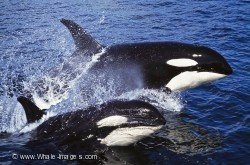

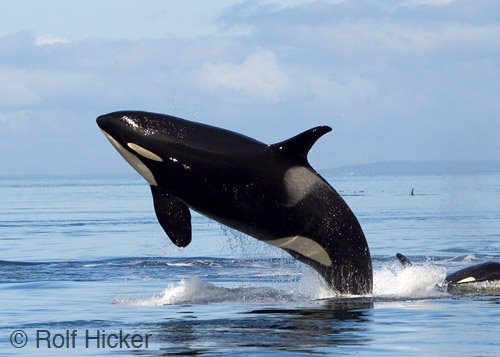
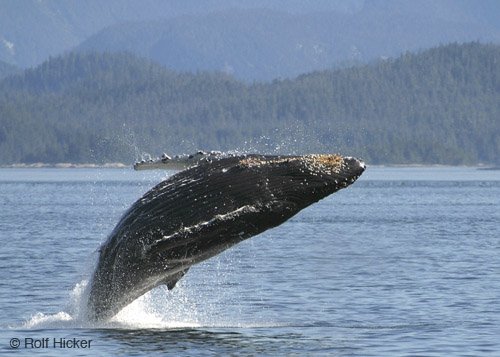

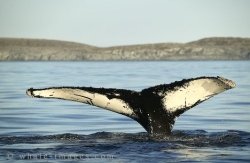

 رد مع اقتباس
رد مع اقتباس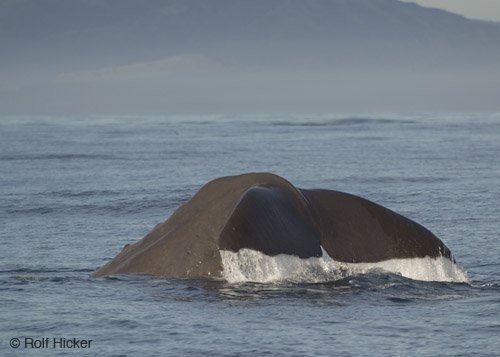
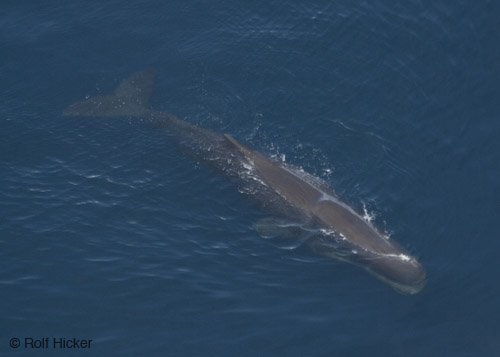






المفضلات